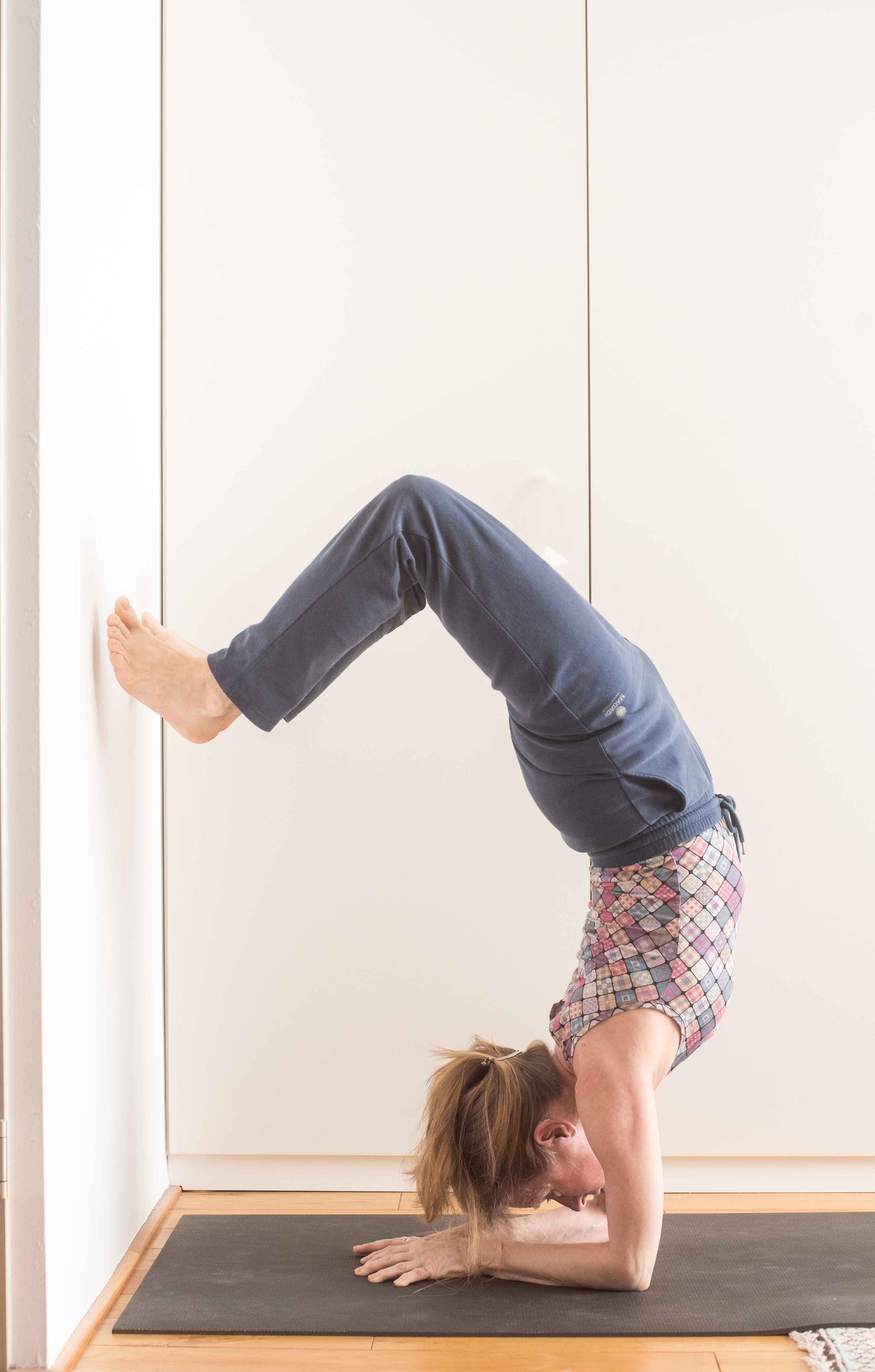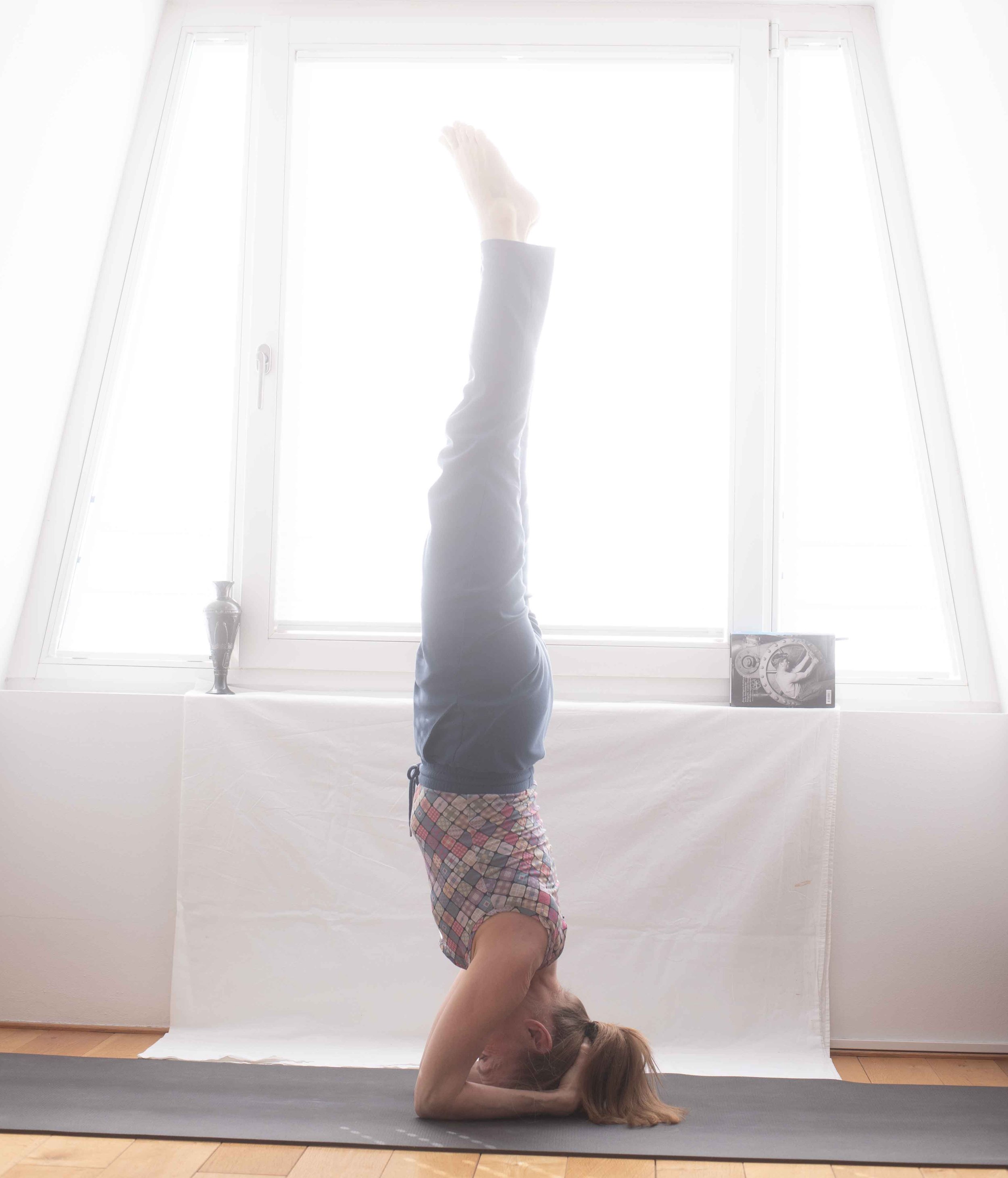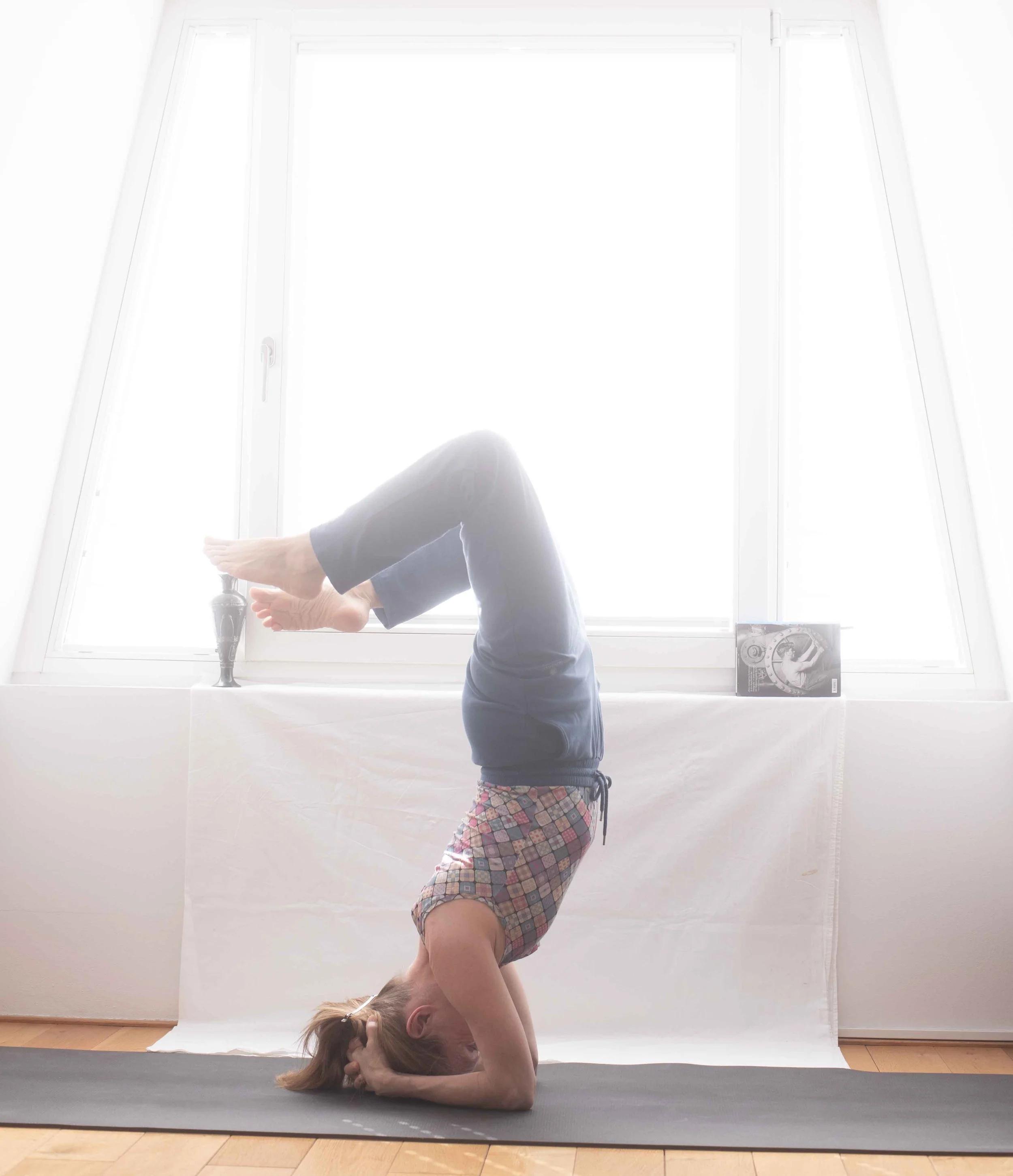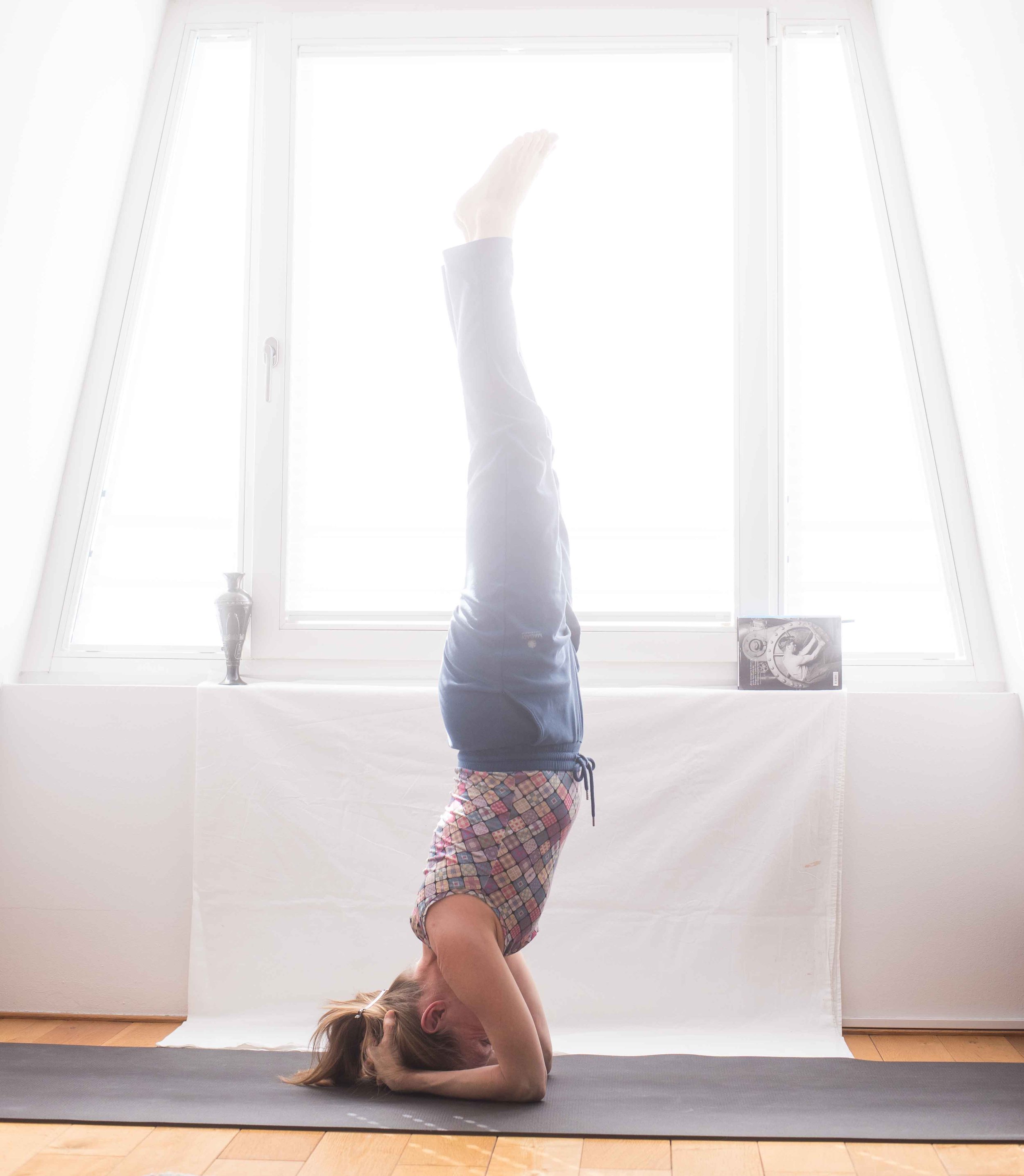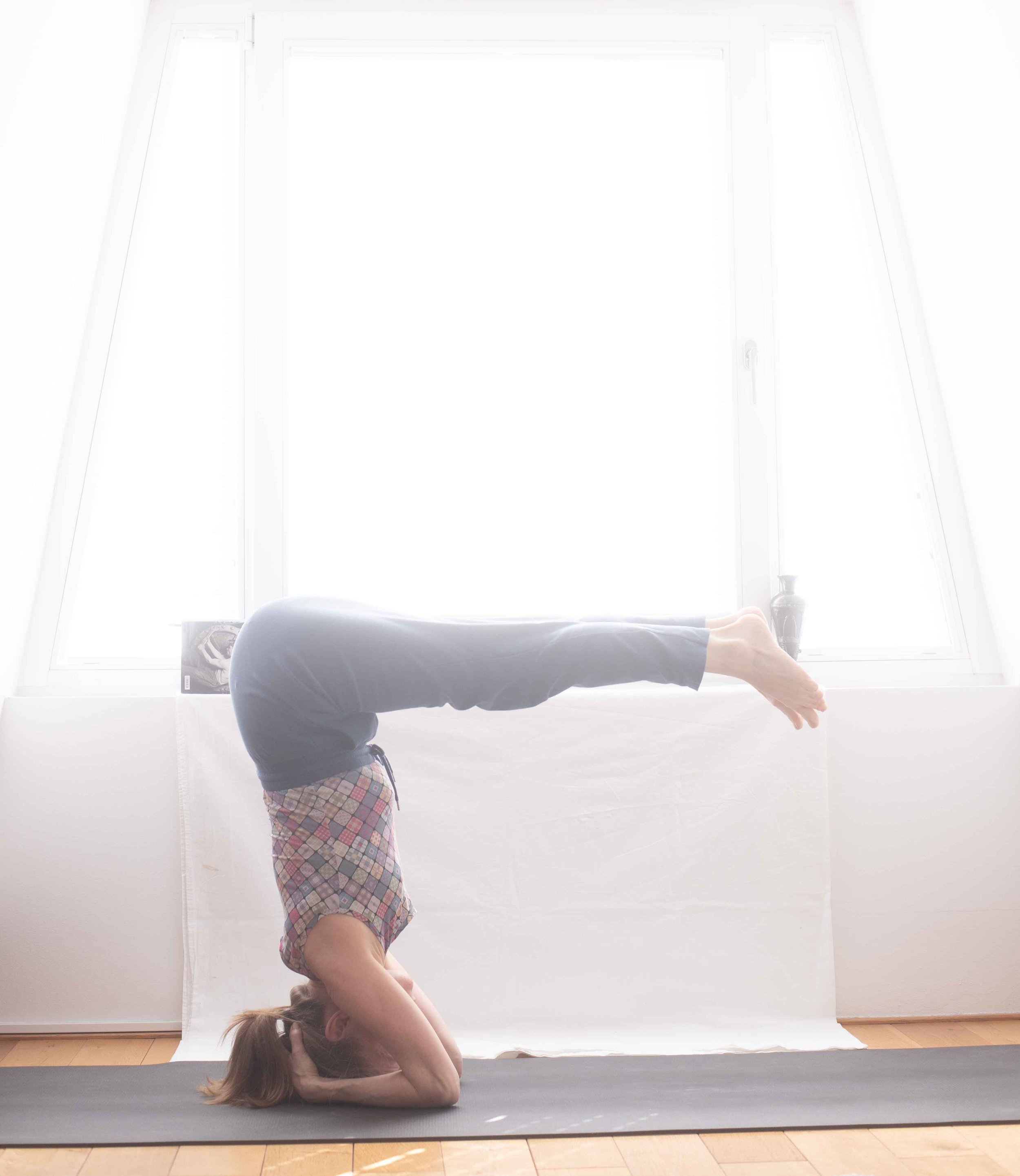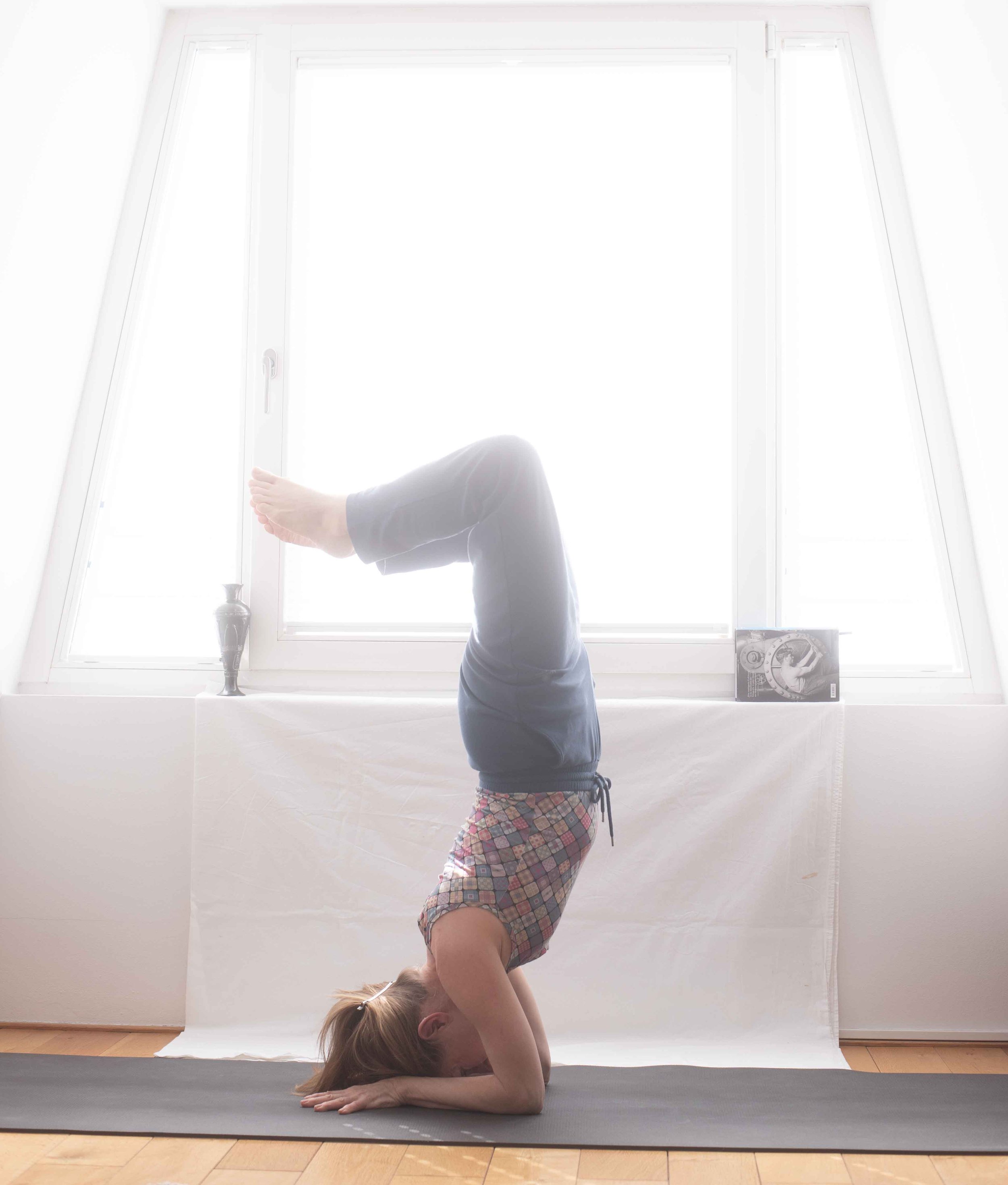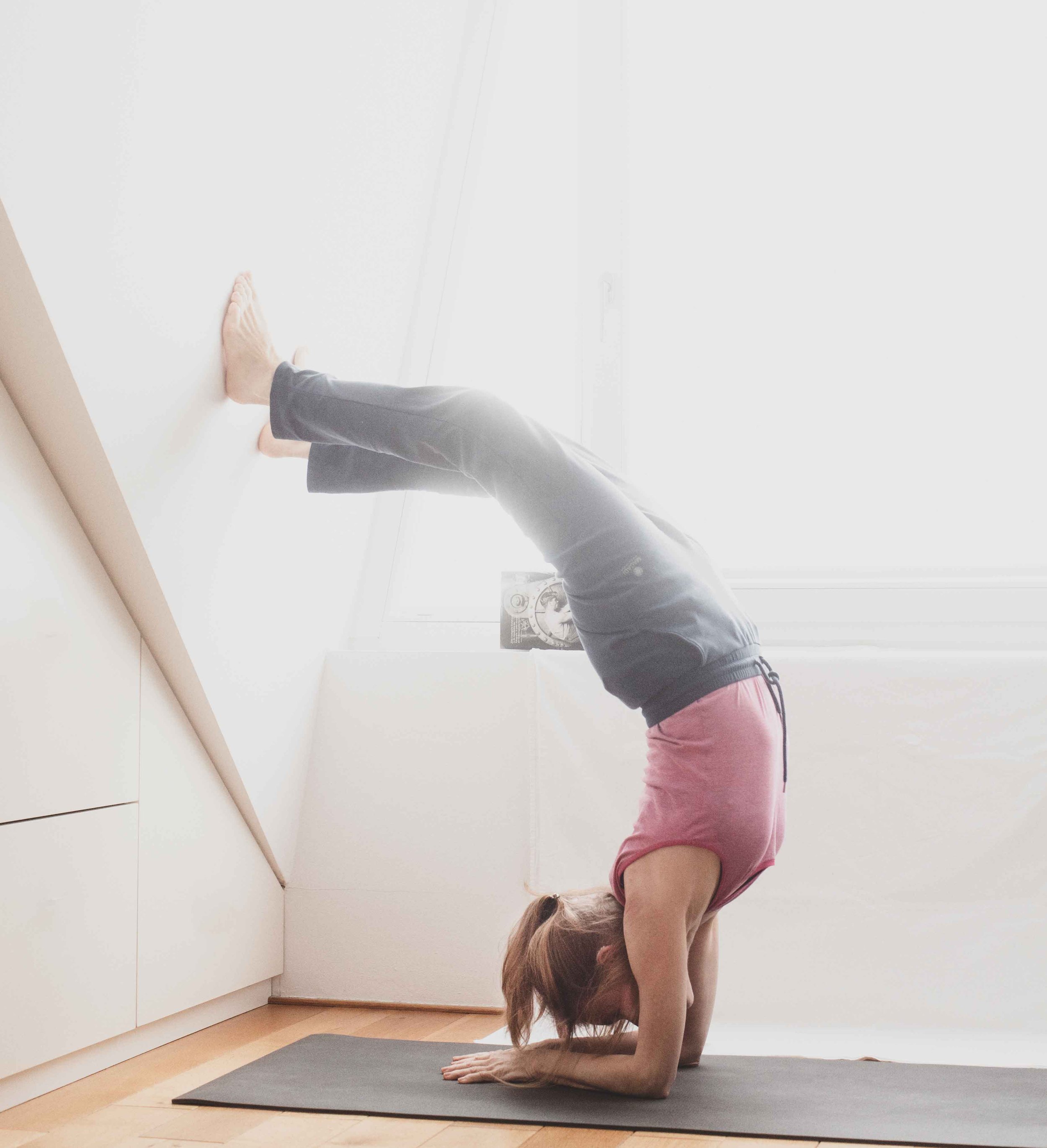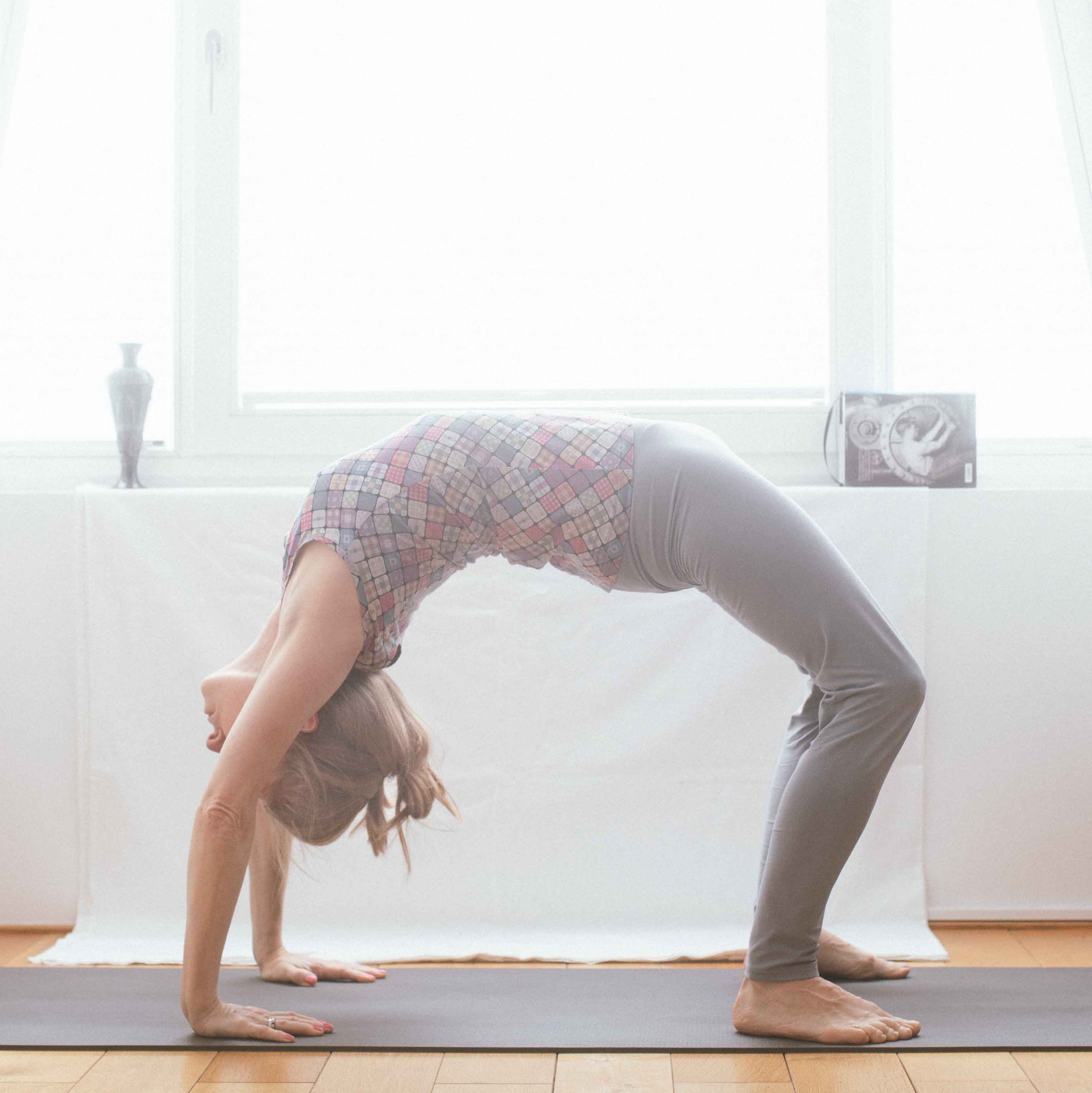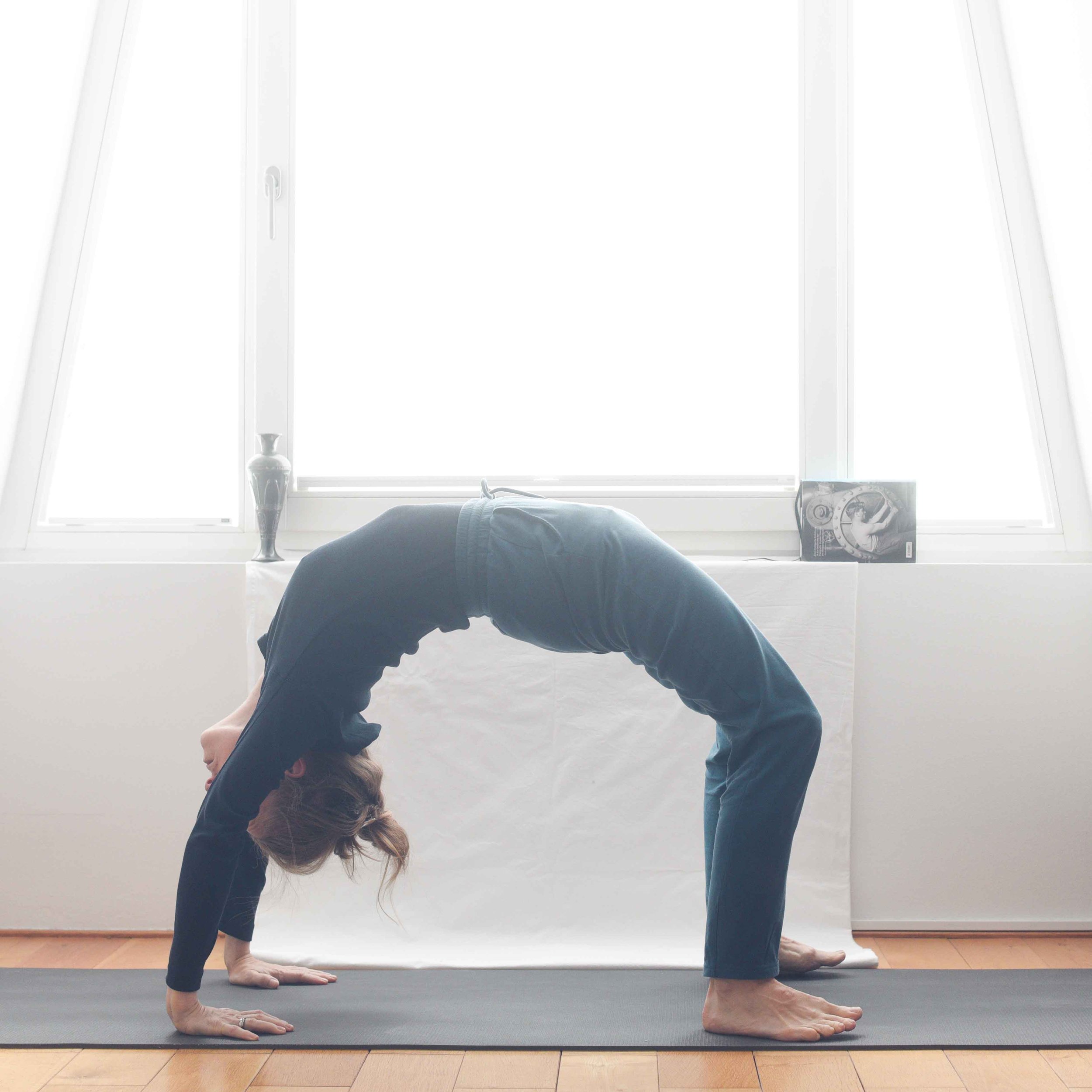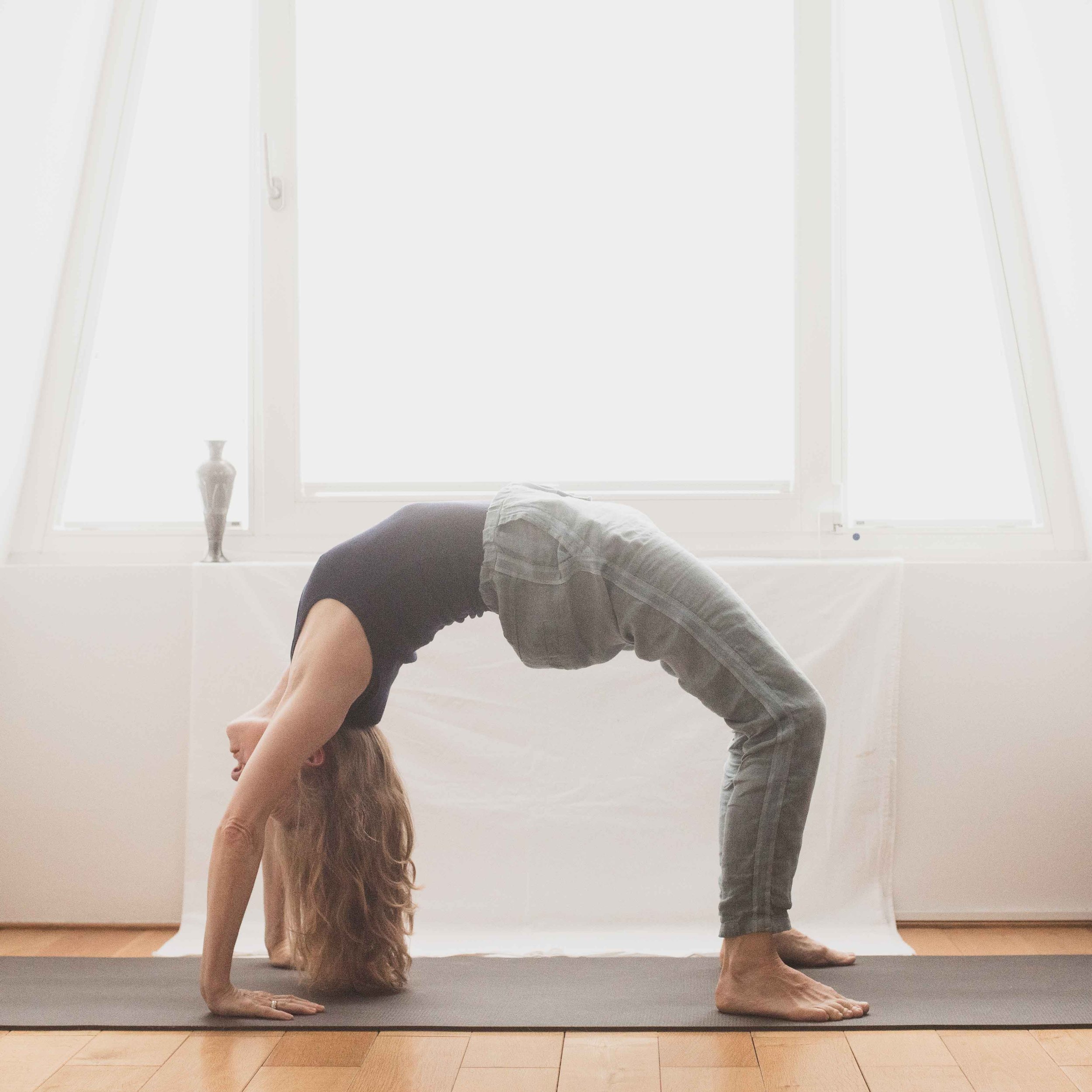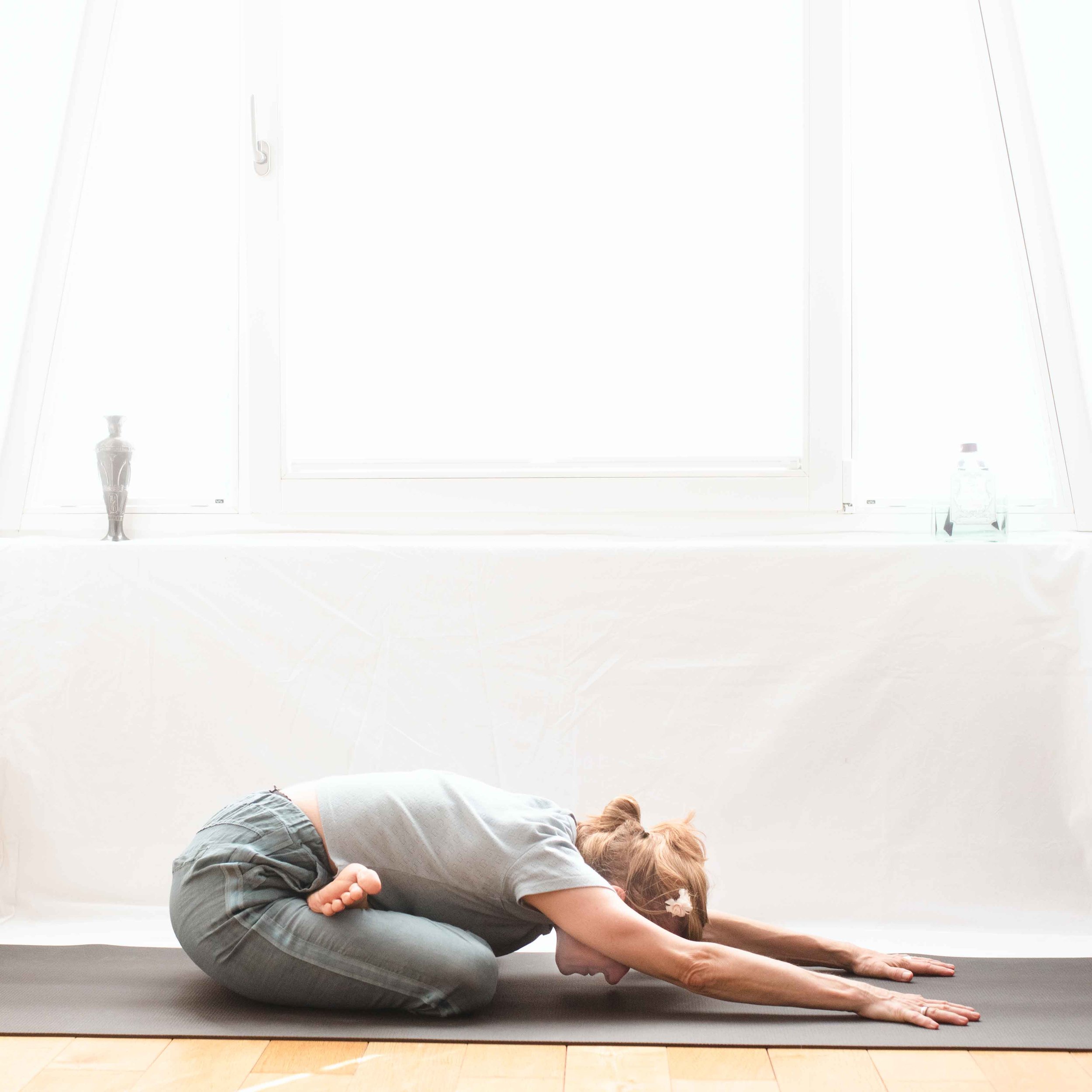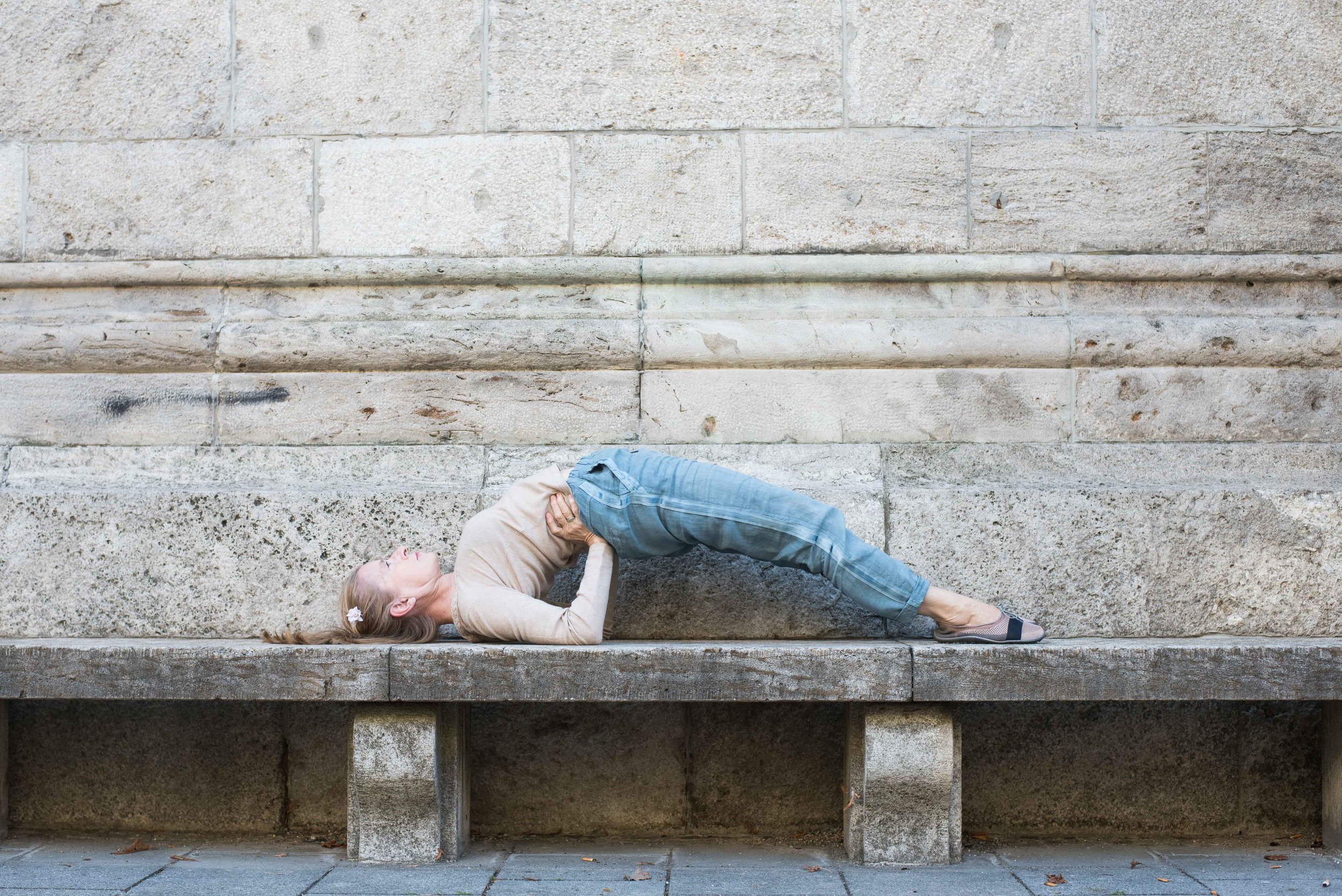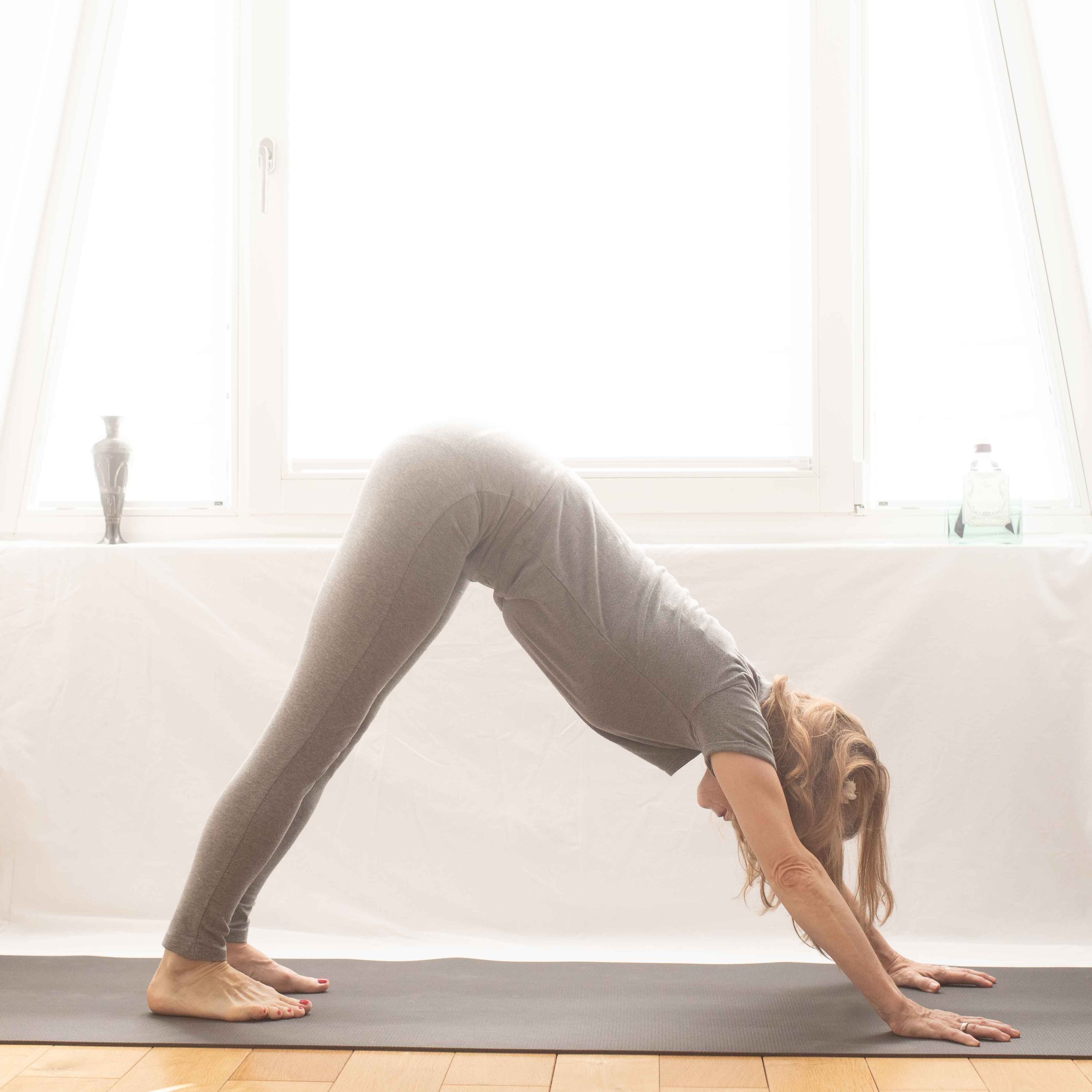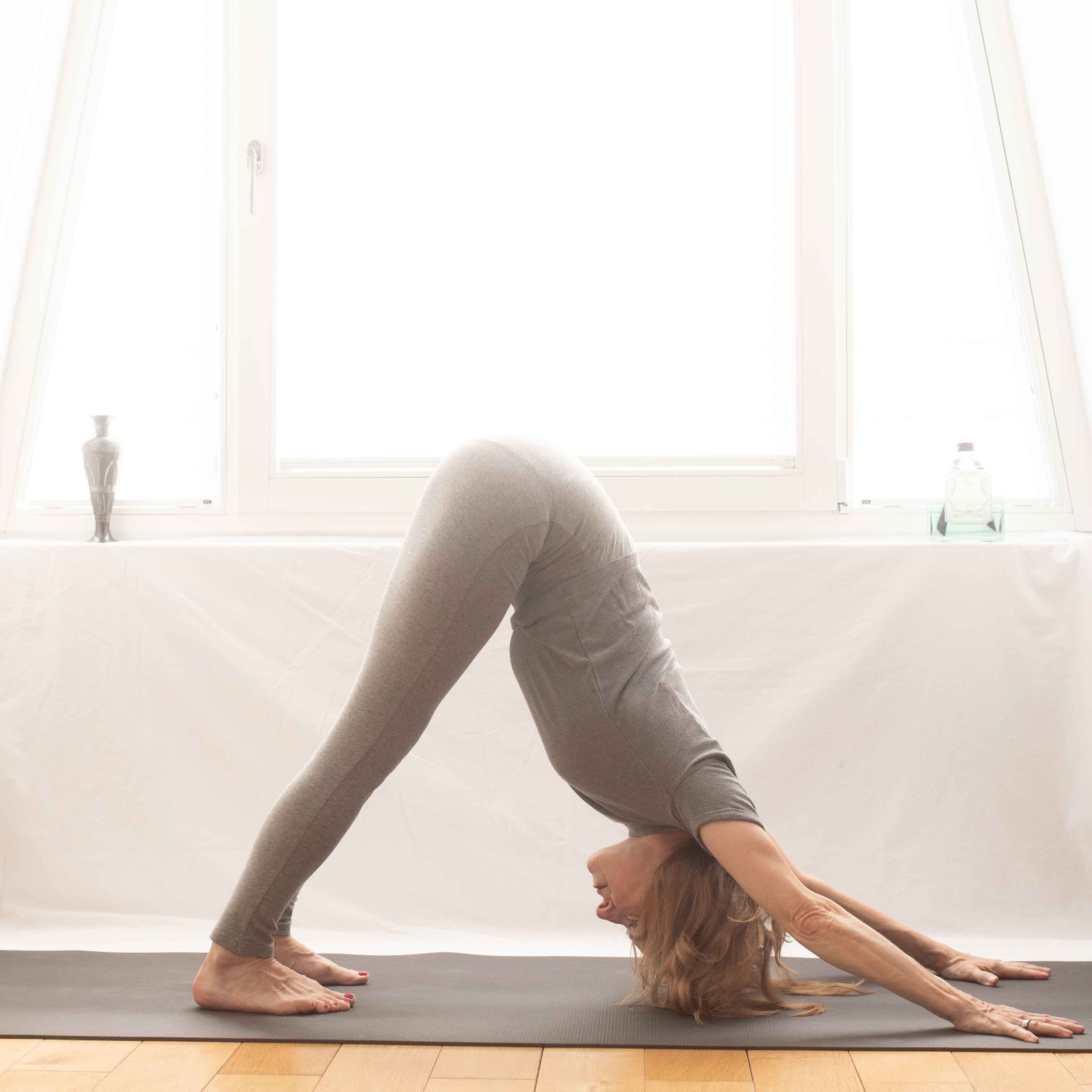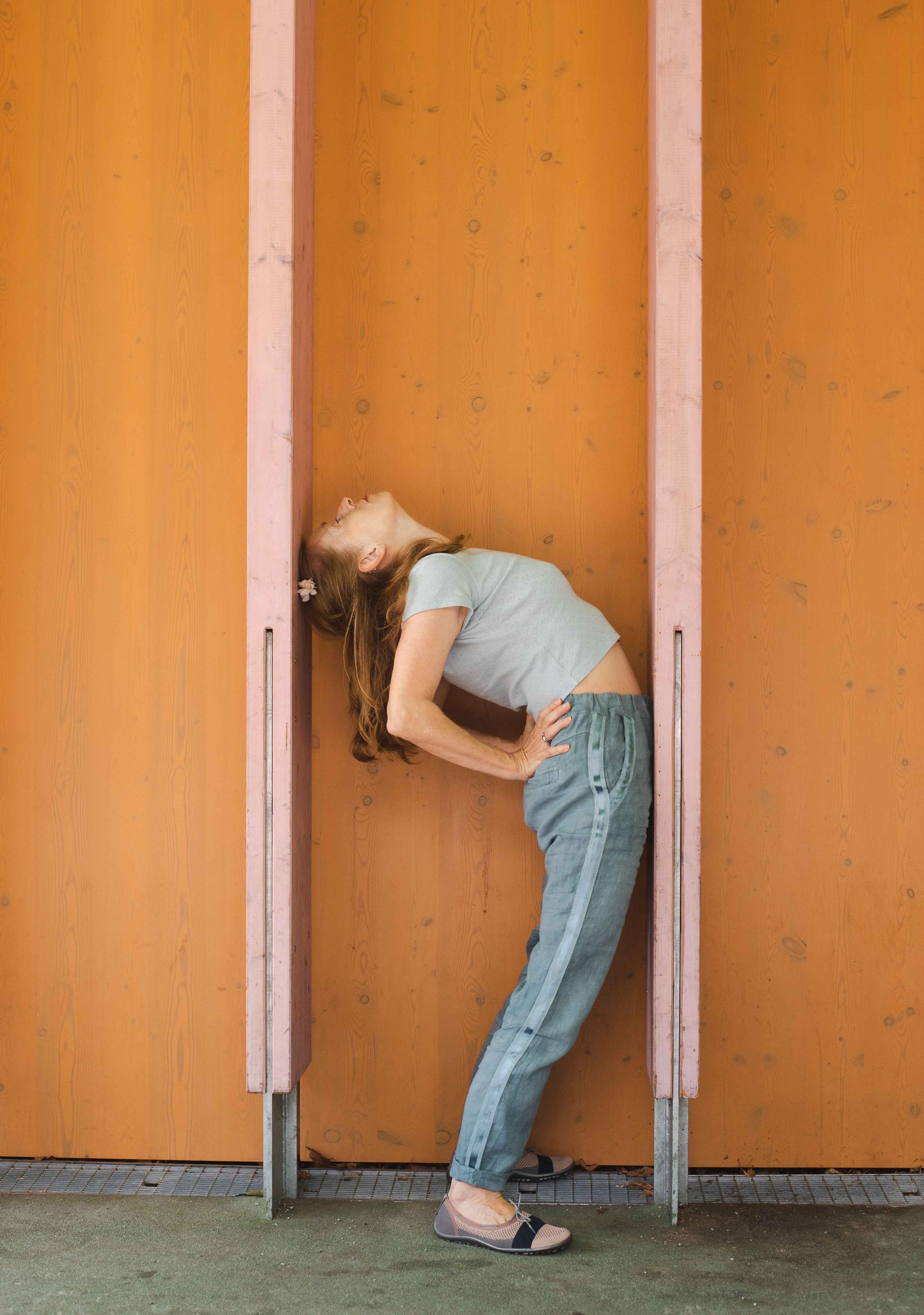Backbending with props
Back bending, Germany, March 2024
You have to push against the wall with your feet. This could help to open up the upper body.
Pictures are always inspiring.
Dhanurasana - a variation
Germany, March 2024, Dhanurasana - a variation with a strap
I'm always trying out new variations of asanas that I already know. I don't mind being challenged. Reach for the stars. You might just end up on the moon. But if you hadn't reached for the stars, you wouldn't have landed on the moon either.
For me, being overchallenged was always better than being underchallenged, even in my jobs in the past.
In today's position, I naturally ask myself: will the hand ever reach the foot? I'll see. Life is an experiment.
Translated with DeepL.com (free version)
Asansa-coaching: From sirsasana to vrschikasana
Germany, Feb 2024, Vrschikasana, first attempts
Yesterday was the Asana Coaching workshop with the Sivanandas. A lot of yogis filled the lobby pretty quickly. It turned out that most of them wanted to do soft yoga. Only four women, including myself, had signed up for the asana coaching. One woman wanted to learn the headstand, one woman wanted to learn the crow and two women, including me, wanted to learn the scorpion from the headstand.
As you can see in the picture: My scorpion already looks different than it did before the workshop. I learned a lot. But I didn't manage to hold the position for even a second. The other yogini, who also wanted to learn this pose, felt the same way. That's not what I expected to learn either. I am more than happy that I dared to try and get into it. In class, the teacher held my ankles so I wouldn't fall out of the pose.
I went home. I was in a good mood and full of optimism. I didn't hurt myself. I now have a sense of my next steps.
The following exercise was suggested for us to do at home:
1. get into a handstand.
2. from there, move your bent legs backwards. Your knees should be wide apart. This helps with balancing. The feet do not have to touch each other.
3. then return to headstand and move your straight legs in the other direction.
4 This swinging movement forwards and backwards strengthens your sense of balance.
The steps to get into Scorpio:
1. get into a headstand.
2. bend your legs over, knees flexed. The feet are side by side.
3. open your hands and place your palms on the floor.
4. the next step is the most difficult: roll your head onto your forehead and push yourself up. This requires strength. It is easier to lift your head off the mat if you push your hands forward. But this is also the moment when you usually fall out of the pose. I can't imagine not falling.
The headstand should never be practiced in front of a wall. Once you start, you will never get away from the wall. I have seen this happen a number of times.
You can do the scorpion posture with the wall as a support.
In spite of this, tomorrow I am going to try to fall out of the posture at least three times. It's very frightening. Only by consciously learning to fall can you overcome it. I think my backbends are good enough that I won't hurt myself if I fall backwards. It's a test of courage, nothing more.
A start has been made.
The instructions for the crow were also interesting. I will write about that tomorrow.
Will I have the courage to fall out of position?
I could film it. Haha........
From headstand to scorpion
From Sirsasana to vrschikasana:
The devil must have been riding me when I signed up for the 2-hour workshop and wished to learn how to go from headstand to scorpion.
I worked on my headstand in February. I can hold it for three minutes. I tend to get bored. Unfortunately, after three minutes I fall out of the pose. After three minutes, I don't have the strength to do slow, controlled movements.
But pushing myself into scorpion requires even more strength. It's madness.
As you can see, the backbend is pretty weak. When I fall out of the pose, I fall from very high up.
I'm going to the session tomorrow with my heart pounding. I definitely don't want to injure myself.
On the other hand, you should always have the confidence to try something. My goodness, some people manage to put their feet on their heads.
There's only one thing I can think of: Keep practising.
Pictures are the most honest feedback I know.
Well, a start has been made.
Let's see what the position looks like next year.
I'm really curious to see how the yogis will teach me to get into the pose without using the wall.
It's going to be an exciting two hours tomorrow. I’ll report back tomorrow.
PS:
There had to be more attempts. The first picture shocked me. The other pictures were better. I got into the headstand a bit further away from the wall. I now had the courage.
I also learned how to push myself up. You push your arms forward. That way you automatically come up.
I'm almost inclined to try a scorpion again.
The pictures prove what I described the other day. You have to trust yourself to do new things. That's the quickest way to learn.
In Ashtanga Yoga it’s an asana of the Advanced B series.
Backbends: Pictures provide feedback
A new month begins. This reminded me that I wanted to see again whether my backbends have improved. There are so many aspects to backbends. Some have actually improved. Others I will have to and want to work on more intensively.
What has improved in urdhva dhanurasana is that the hands are closer to the feet than they were some time ago. My splits exercises, which stretch the hip flexors, are paying off. I was really happy about that today. There are only three and a half wooden planks between my hands and my feet. Hallelujah.
But I find it difficult to push myself up into the position. This has to do with strength again. I can work on this in February.
A good exercise for this is to push yourself up again and again, like with push-ups or squats, only differently. First I want to find out how many repetitions I can do and work from there. Three sets of the repetitions I can just manage and do them every day. What a great plan. Haha......And then I lie on my back tomorrow and want to push myself into urdhva dhanurasana and then I think 'oh no', 'how exhausting', 'I can't'. But I can go from this 'I can't' to 'I want to, I can'.
Then we'll see what the backbends look like at the end of February.
What has improved over the years is my concentration. I don't like to interrupt my practice by taking pictures. But pictures are the best feedback I know. I also need pictures for my blog post. They also motivate me and bring me a lot of joy. I have found a solution. I prepare everything before I start practicing. I roll out the second yoga mat where I can take the pictures. The camera is set up. I basically just have to pull the trigger. This makes it possible to take pictures without interrupting the exercise too much.
I have also found a remedy for my left hip. I always have Tiger Balsam from Singapore in my medicine cabinet. I spread the camphor generously on the inside of my left hip. I already noticed improvements today. Could that be? It was like this.
Keep practicing.
The perfection trap
Germany, December 2023, urdhva dhanurasana
My goal was and is to photograph the asanas of the four Ashtanga yoga series. Of course, you have to be able to perform these asanas first.
Well, I definitely wanted to get from urdhva dhanurasana to standing before I started photographing the 2nd series.
And I wanted to get the heels on the floor in pashasana before photographing this asana and then the next asanas. I also wanted to keep to the sequence.
I had set the bar so high that nothing happened in the end.
Who knows how long it will take me to get the heels in pashasana on the floor? At the moment, I'm happy when my fingers reach each other. I'm a long way from reaching the joint.
Coming into standing from urdhva dhanursana is very challenging. Who knows when I will succeed. In a month, in two years?
Next year I will change my approach to the goal of photographing the asanas in the Ashtanga yoga series. I will photograph the asanas that have reached a level that I am happy with. More is always possible. Then I will see which asanas remain. I can then devote myself particularly intensively to these hard chunks.
The journey then goes from easy to difficult.
Today I realized again how important it is to take pictures. They provide important clues as to the direction in which you can continue practicing. Taking pictures interrupts the flow. The focus is more on the pictures than on the exercise. But pictures are so helpful that I don't want to do without them. It's also super interesting to see the difference between feeling and reality.
Urdhva dhanurasana - an analysis
Urdhva dhanurasana, Germany, August 2023
I quite like what I see. The bridge is very symmetrical. I also manage to press myself straight into the position. The elbows are as good as stretched.
I also see that there is still potential.
- The hands could move even further to the feet or vice versa.
- The hips could be stretched further.
- The neck and also the upper body and also the shoulders could be stretched further.
This is immediately a plan. The individual body parts can be trained in isolation.
Strength is also needed. It happens to me again and again that I lie on my back and then think: Oh no, now push the entire body up, my goodness. I think it's because of the strength that's needed here, or rather the lack of strength. The position becomes easier when you are stronger. You can also think of the whole exercise as a strength exercise. You brace yourself against the normal straight posture.
In Callisthenics, the bridge is also an exercise. You keep pushing yourself into the position. The colleagues in the other gym see the position as a strength exercise first and foremost. For the yogis, everything is stretching first. You push yourself into the position over and over again.
One goal could be to aim for three sets of twelve repetitions.
So many ideas, and time just runs out.........
Back bending exercises
Shoulder stretch in adho mukha svanasana, Germany, August 2023
There is often not enough time to practice again in the afternoon to do all the asanas that I would like to do. Rolling out the mat twice a day doesn't often happen, even though the good will is there. Therefore, I try to integrate exercises that I would like to do into my Ashtanga Yoga practice in the morning.
At the moment I am working more intensively on backbends again. It is easy to add a shoulder stretch after urdhva mukha svanasana. Normally urdhva mukha svanasana is a triangle. When you stretch the shoulders and move the head to the floor, one side of the triangle becomes a curved line. The exercise can be performed dynamically and statically. It is not a very intense stretching of the shoulder area but it is an intense warm-up.
When practicing alone, one can arrange the exercise session as one considers appropriate. One can respond to one's own needs. For almost all asanas I can think of easier and also more difficult variations. Depending on the condition, the routine becomes more challenging or more relaxed.
Going to a yoga class every day is a lot easier. You pack your bag with your yoga clothes, you take your yoga mat and that's it. Once you leave the house, everything goes by itself. There is no turning back. Not much discipline is required.
Practicing alone always takes discipline. You learn to motivate yourself. Through this, you also get to know yourself. One remains independent. But there are always days when you struggle through the exercises much more than you would in a group.
Ultimately, it is also a goal to be able to practice alone.
Migraine
Last night these unbearable headaches already started. At first everything was still halfway bearable. At some point I took the first aspirin and later the second. They did not really help well. I rolled around in bed as I lay down to sleep. Lying still was impossible. Impatiently I waited for the morning. At 4:30 a.m. I got up. Sitting up made me feel better. But sitting through the night was also too exhausting for me.
After a few hours I felt better. It was already light when I went to bed again and slept a round. It was the sleep of exhaustion.
When I finally got up, I didn't want to practice yoga with all the vinyasa. I was afraid the migraine would return.
Instead, I went for a walk. Soon I bumped into all the Wiesn visitors. Today was the last day of the Volksfest. I don't want to know how many of them got another good headache today. Such a beer intoxication is also not without.
It is the beginning of October it begins not only a new month, but also the last quarter of 2022. My zeal has got a damper by the headache.
Still, I managed to photograph the first three postures of the October challenge in the afternoon. The community around Carmen on Instagram @cyoglife is very nice. In October, the scorpion is the theme. Carmen has prepared a position for each day, most of which are very challenging.The yogis have again posted their versions of the asanas on Instagram. It is a pleasure to go through the pictures.
My personal theme for October is the vinyasa. All of them.
The backbends will continue to be practiced. My focus is shifting for a time. Vinyasa also always means practicing on strength. This will be good for me.
.
Have a good start into October.
Keep practicing. Keep practicing.
Translated with www.DeepL.com/Translator (free version)
Counter poses after back bending.
Forward bending asana, September 2022
On Sundays, Mondays, Tuesdays and Thursdays I focus on back bending. The last practices were rather intensive. On Tuesday I realised that my sacroiliac joint was not so content. I felt a slight discomfort. I had to take care not to do the tiniest awkward asana.
Today I practiced forward bending asanas. And all seemed OK again. The body needs balance.
For me it’s good advise to practice forward bending asanas after having exercised deep back bending asanas. It relaxes the back. It balances the entire practice. It’s not about bending backward for 90 minutes.
Twists and forward bending asanas relax the spine again after deep back bending asanas.
I’ll take care of this even more from now on. If one is attentive, the body gives messages.
To practice primary Ashtanga on Wednesdays and Fridays seems to be very good. The body needs time to integrate new movements. It counter balances the days on which I focus on back bending.
It’s not about progressing as fast as possible. I want to avoid injuries.
Working on the core muscles also protects the back.
Counter poses are not boring. They can be very relaxing.
Paschimottanasana after urdhva dhanurasana was often too much for me as a counter movement. The back hurt. These days I move slowly into forward bending asanas.
Hanging forward is great. Baby pose is great. Also a simple squat pose helps to relax the back again. After these easier forward bending asanas my body is ready for paschimottanasana.
I learn to protect myself.
Take care.
Don't be a lazy yogi.
Back bending, September 2022
With each attempt this pose got better.
I struggled with the pose and with the camera. First I used my phone. The results were not convincing. Then I used again my camera. I feared not having enough distance from camera to where I performed the asana. Yet it was possible.
At the place where I usually take the picture I don’t have a wall. For this exercise a wall was necessary. It’s another asana of the September challenge with Carmen ( cyogalife ) on Instagram. I show on my blog only the back bending asanas, because I focus on back bending in September.
Carmen’s challenge is a good opportunity to try out new poses and to have fun with the yoga community.
Every time I exercise back bending the body gets a tiny bit more used to the movement.
Today I realised again how important it is to have a reasonable didactic to learn back bending. It’s not just doing it. It’s often a waste of time and one risks injuries. To have the goal to learn urdhva dhanurasana for instance is great. Yet how to get there is an important question. Just do it and one day you’ll be there is not enough. Perhaps you’ll be able to master this pose in your next life I even heard once. Progress must be seen faster. I’m convinced it is.
Sometimes one has to step back to have a closer look at one’s own exercises. A critical view is necessary.
Having watched the course with Ugi, a contortionist, on Omstars accelerated my progress enormously. I feel how the exercises help. And it feels save what I’m doing. Sometimes it’s worth to spend money to get advise from the real experts. Yeah it’s difficult to find out who is truly informed. Many think they know everything, but do they?
Picture: This morning I read that the butt is supposed to be on the wall. This would have been possible. I’ll try it next time.
Back bending - the upper body.
Back bending, September 2022
There are four obvious parts of the body that need to get stretched when doing back bending:
The thighs.
The hip flexors.
The upper body.
The shoulders and arms.
(Of course the entire body is involved when practicing asanas but it’s possible to focus on special areas.)
To exercise certain muscles isolated is not so overwhelming like exercising the entire body together. It helps to deepen the understanding of an asana. It’s effective. It’s possible to adjust the exercises to one owns need. Some have flexible arms, others are stiff there. Most people have stiff hip flexors, but there are also people who are very flexible, but lack strength for instance. There are the ambitious and the talented. It’s good advice to individualise the training.
In the above picture I stretched my legs. I pushed the feet into the ground to push the upper body towards the head. This is a relative easy stretch. This exercise gives the body the opportunity to get used to this sort of stretching. The hands support the back and the movement.
More challenging asanas will come.
I usually integrate exercises in my morning practice.
Stretching takes time and patience. Every injury means a set back. Consistency is the key.
Back bending - stretching the hip flexors
Back bending, Sept 2022
I put a block under the sacrum and stretched both legs. The goal was to stretch the hip flexors. Muscles stretch when they are relaxed. A deep and even breath supports that the muscles and the entire body relax.
It takes time till the maximum stretch is reached. After a while I could go deeper. Then I added variations. I stretched one leg to the ceiling. Then I changed the leg.
I also moved the feet backwards. It’s a deep stretch of the thigh and the hip flexor. My pictures told me that the upper legs were no more at the same level like the stretched leg. The bent leg was much higher. It didn’t feel like this. I moved the foot further backwards. This intensified the stretch.
With one leg bent, I realised that the shoulders lifted up from the floor as well. This is a sign that this exercise has still potential. Gravity helps in this position. The trick is to hold this pose long enough to get results. Two minutes up to five minutes will be good.
Next time I try the exercise with a towel or a soft cushion on the block.
When I started my yoga practice today, I felt stiff. Don’t expect too much today, I thought. I started slow and took it easy. Very soon my body become softer and stronger. The practice became so wonderful.
Practice with the body not against it.
Back bending positions hide everywhere.
A classic downward facing dog (adho mukha svanasana) looks like a pyramid.
In order to get a stretch for the shoulders and upper back one can move the head to the floor. To squeeze the shoulder blades supports the process.
I start with a dynamic phase and swing the upper body in direction to the legs. The head gets closer to the floor. After 12 times I stay in the position and try to get even a bit deeper.
This looks not very dramatic when I’m doing it.
That’s why I do these exercises.
Back bending is the focus in September.
Arm and shoulder stretch, September 2022.
I don’t want to stop the process that has become so interesting lately. All the back bending asanas and exercises that I did during my morning practice last month helped me to find back bending less difficult. This cannot be seen dramatically, but I feel it. I feel much less resistance to bend backwards.
I found 2 excellent teacher who help me on my back bending journey: It’s Ugi on Omstars (this is her Instagram page) and Anmol Singh on YouTube. The videos that Ugi and Anmol produce are excellent. Both are super experienced. The sequences are well thought through. I get out of my routine that makes me feel stuck. I’m amazed how many exercises support the back bending journey. Trying new poses and routines raise the attention. I have the feeling I leap ahead. I’m happy with tiny steps as well.
Ugi and Anmol teach also very advanced asanas. It looks all easy when they do it. Yet some asanas are not doable for me. One can pause the video and exercise the asana several times. This. is one possibility. Repetition helps to get deeper into a pose and to understand it better. Nevertheless I also have to omit some very advanced asanas. To reach my feet with my hands when bending backwards won’t happen overnight, also not within a month. It’s important to stay creative. It’s not necessary to follow rigidly a sequence.
One must pick oneself up at the level that is comfortable. From there one can push forward. Tiny steps are great. These tiny improvements are underestimated. It adds up. Breaks ruin the progress. Keep practicing is easy said, but so important.
My development is slow, but steady. I also know set backs.
The pose in the picture stretches the shoulders and upper body. The fingers are interlocked, the palms face the ceiling. I move the arms backwards. A stretched upper body is necessary for a deep urdhva dhanurasana. It’s possible to repeat this little exercises whenever it crosses one’s mind.
My goal for September is to drop back again into urdhva dhanurasana. I’ll work on coming up to a standing position as well. Therefore the hands must walk closer to the feet. 🦶 A courageous goal.
Flexibility can mean a lot.
Kapotasana, August 2022
This morning I slept too long. I had an appointment at 9:30 am, so the time for an Ashtanga Yoga practice was too short. It should be so. Sleep is important as well.
A plan is only an orientation and not written in stone. In the afternoon I don’t practice an Ashtanga Yoga series anymore. But I know so many sequences and asanas that I want to exercise that it’s easy to fill an hour. That’s what happened. At 3 pm I stepped on the mat and started with a warm-up. Quickly I focused on back bending exercises.
I took pictures.
My camera is like a pushing teacher. When the self-timer starts blinking I run to the mat. Most of the time I’m able to push my limits. Today I dropped back from a kneeling position into kapotasana. I haven’t done this for ages.
Since a decade minimum my hands try to reach the feet. 🦶 They don’t come closer. Now it’s too late to give up. Giving up is not an option either.
Some yoga teacher have kapotasana as a warm-up in a sequence. This makes me laugh hysterically. I mean reaching the feet with the hands when bending backwards is an advanced asana. I know a lot of people who have difficulties to reach the feet with their hands when they bend forward.
I sweated a lot during the practice. It’s warm here. The body is flexible in summer time.
Tomorrow I don’t have an appointment in the morning. Nothing will stop me to practice Ashtanga Yoga in the morning. When I dropped back into kapotasana today it’s very likely that I can drop back tomorrow as well. I’m ready to get surprised.
I’m looking forward to my yoga practice tomorrow.
Repetition
Back bending, August 2022
I repeat difficult asana. Ushtrasana, laghu vajrasana, kapotasana, urdhva dhanurasana are challenging asanas. Repetition is a possibility to realise that the body can relax into a pose. With each repetition the pose becomes a tiny bit easier. The discomfort fades away slightly. Repetitors allow to get deeper into a pose.
Sometimes I think that this is a nightmare to repeat a difficult asana that comes with a lot of discomfort. The opposite is the case. Usually the second try feels better. Often I can get deeper into an asana. The same is true for the third try. It’s getting easier with each repetition. The body gets used the movement. Deep breathing helps to relax.
The felt progress motivates.
I know yogis who repeated urdhva dhanurasana up to 50 times against the wall.
Usually three repetitions might be enough. To intensify the exercise I hold the asanas as long as I can. Or I set a timer for 1 min up to 5 min.
How to move into a back bending position?
Back bending, August 2022
I’m through the back bending workshop. I watched all the 9 videos on Omstars with contortionist Ugi. It will change my back bending practice.
Ugi is a contortionist. She has been trained since she was 7 years old. This is for me enough qualification. I trust her and her method to improve back bending. She cannot risk injuries.
She advised to point the toes slightly outwards. Otherwise it will become difficult to move out of a deep back bending pose like urdhva dhanurasana..
Stretch your butt out. Ugi repeated this again and again. The curve of the spine gets emphasised before doing anything else. This is really the huge difference to my current movements. It feels better. I also allows me to go deeper into a back bending asana. I used to lengthen the spine.
The shoulder blades move together.
The head relaxes backwards.
This is the start. Then one can move the hips forward, without changing the curve of the spine.
The back bending journey can beginn.
We were taught a lot of variations, yet there were also repetitions of exercises during these 9 classes. Doing anything once is like nothing. Repetition is a key if one wants to progress. Holding the asanas for quite some time is another method to improve fast.
After an intensive back bending followed a forward bending position in order to relax the back.
I’m enthusiastic about these 9 classes. I feel very inspired. Many of the exercises will become part of my daily routine. Blog posts about these exercises will come.
Back bending - neck stretch
Neck stretch, August 2022
The stretch looks superficial, yet I reached my limit. With time the hands might be able to slid down on the wall. This will intensify the stretch. The chest shall keep touching the wall.
Even more important is the curve in the lower back. Ugi repeated it again and again. Stretch your butt out. This is exactly the opposite of what I did by now. I tried to lengthen the spine in order to stretch the front side of the body. But the front side will stretch anyway.
Ugi is a cotortionist, who taught classes on Omstars. I trust her more than any other person. She must know it as she lives from her flexibility. She must take care that she won’t injure herself.
For a week now I tried this new approach to back bending. I first stuck my butt out and then I bent backwards with the upper body and the head of course as well.
It feels better and more natural to emphasise the natural curve of the spine.
This difference in moving into a back bending asana is like a a revolution. It alters everything. It allows me to get deeper into a back bending asana.
My goal could be to touch the wall with my butt. It will take some time………
Back bending - neck stretch
Neck stretching, August 2022
This is a very intensive neck stretch. The upper body is supposed to be on the wall, the chin too. With time one can move lower and lower with the arms. Not only the neck, but the entire upper back is challenged including the shoulders. Holding the pose for quite some time and breathing in a relaxed way supports the stretching activity.
The picture shows: There is a long way to go.
I don’t feel stuck anymore as I’ve learned so many new exercises that I can integrate in my daily practice.


